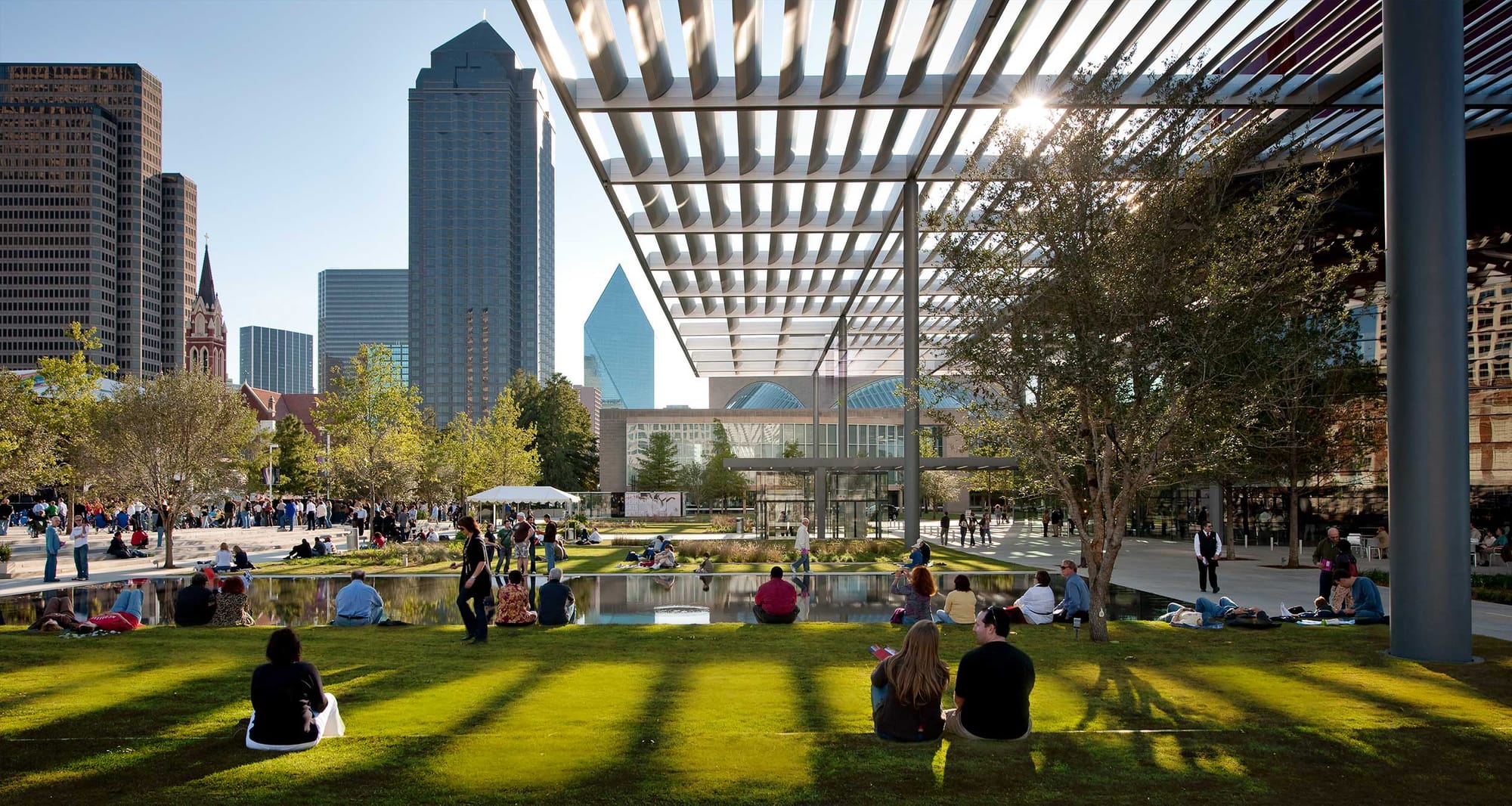
New York, Chicago, Los Angeles – these are cities that tourists feel obliged to visit because of the hype surrounding them. While they are each great cities in their own right, they won’t feel “local.” Few cities do. But I quickly discovered that Dallas is one that does.
In this section of the travel guide, I will share the top attractions and sights in Dallas, providing information on their wheelchair accessibility. But rather than writing only about museums, art galleries and observation towers, I’d also like to share information on the neighborhoods that surround them. I am confident that you will want to “roam” around Dallas, to experience local flavors and encounter local people. Dallas is a city big in community and heart – something you won’t want to miss.
Downtown Dallas (Neighborhood)
Although Dallas is the ninth-largest city in the United States, its downtown area will seem to be quite compact. The distance between popular attractions and a wave of investment and revitalization have made (and are making) Dallas much more wheelchair friendly.
Sixth Floor Museum (Texas School Book Depository)
The Sixth Floor Museum at Dealey Plaza tells the story of the most recent presidential assassination in U.S. history – that of John F. Kennedy in November, 1963. In this building, formerly the Texas School Book Depository, Lee Harvey Oswald fired the fatal shot that claimed the life of the President of the United States.
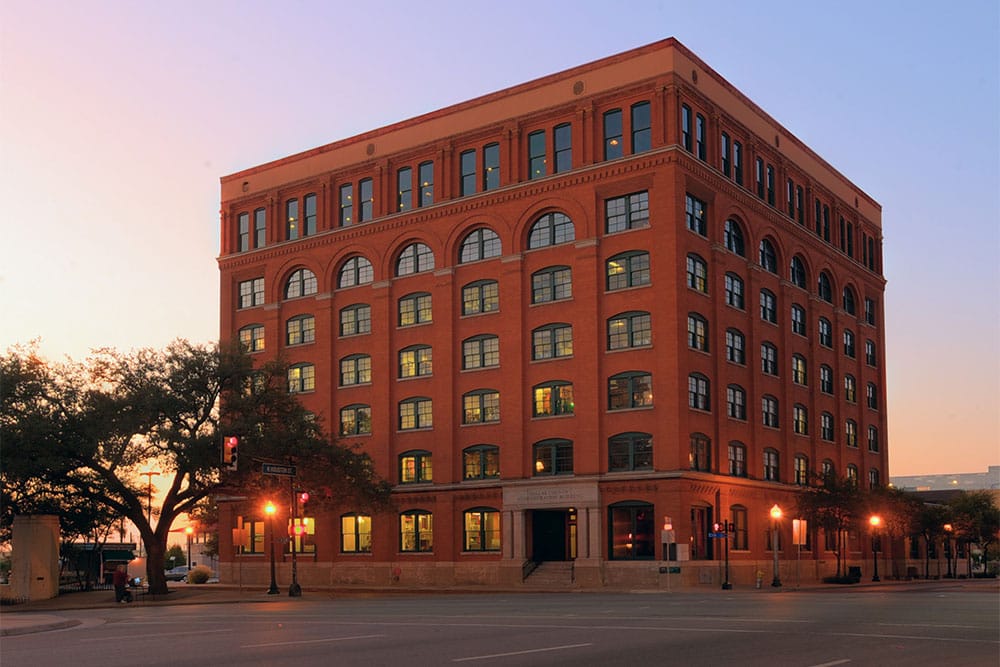
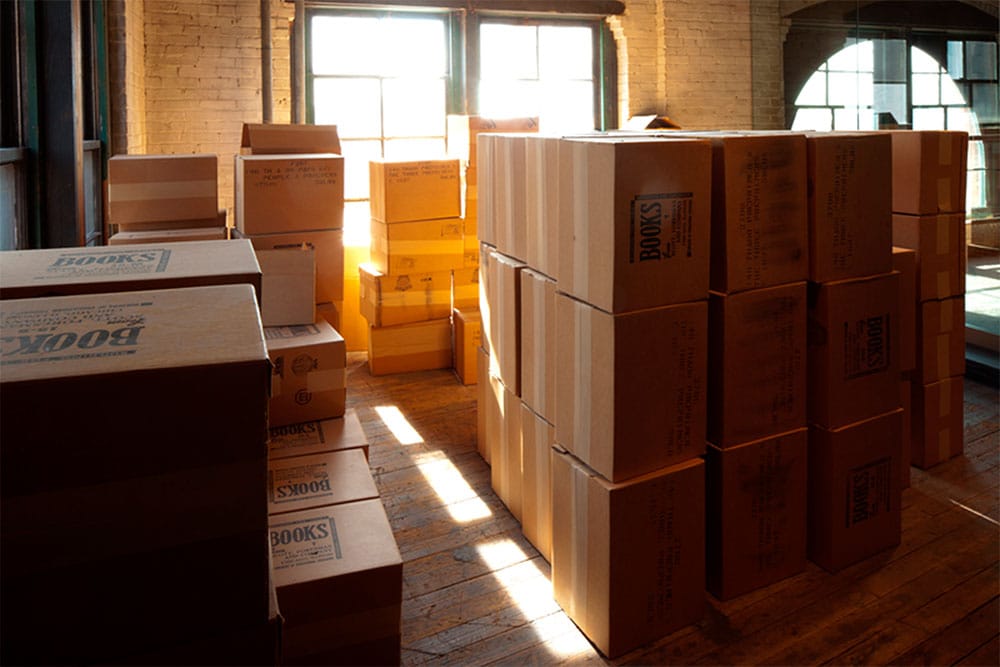
The exhibit on the sixth floor takes visitors through that fateful day – inside Kennedy’s Texas tour and ultimately to Air Force One, where Lyndon B. Johnson was sworn in as the 37th President of the United States. The audio tour guide is the quickest way to experience the exhibit, pausing to read more where necessary. Visitors should allot two hours for the tour.
Because photography is not permitted, I am limited to sharing the stock photos above. The second photo, on the right, is the area in which Oswald set-up his rifle and assassinated Kennedy. The space has been reconstructed to look as it did on November 22, 1963. You’ll also have the chance to see other artifacts from that day. Most interesting to me were the audio and video reports broadcast in the immediate aftermath of the attack.
The entire tour is wheelchair accessible, via a ramp at the rear of the building and lifts to bring you to the sixth and seventh floors. On the seventh floor, you’ll be able to look out the window that is directly above the “sniper’s lair.” Visitors are permitted to take photos from the seventh floor window. The cost of admission is $16 for adults and $14 for seniors (ages 65+). For more information about the museum, visit www.jfk.org.
Nearest Metro station: 0.3 miles from West End Station (Blue, Green, Orange, Red lines).
GeO-Deck at Reunion Tower
Reunion Tower is a landmark in the Dallas skyline, standing at a height of 561 feet. Built in 1978 along with the now-connected Hyatt Regency Dallas Hotel, the tower was used to broadcast FM radio signals and held a restaurant high above the city. Today, Reunion Tower contains an observation deck, restaurant and event space.
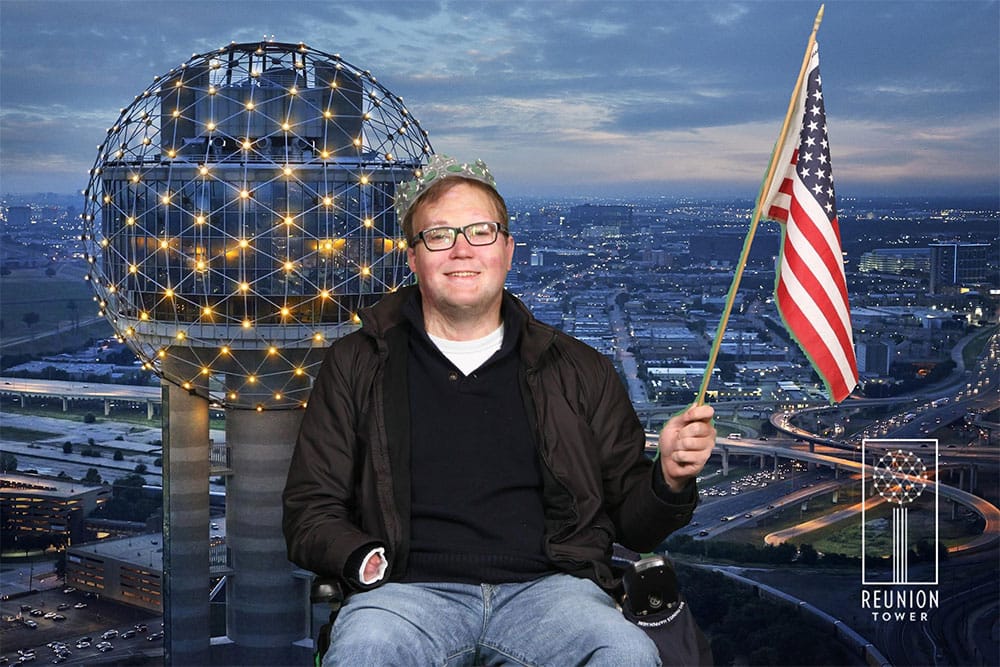
The weather outside was quite poor during my visit to Reunion Tower, but I still had an enjoyable time. Once at the top, you’ll be able to take in a 360-degree view of the city from the climate-controlled observation area. Grab a drink and a snack on this level, and read about all of the buildings and places you can see on the interactive touch screen displays. To get a closer view – roll down a wheelchair accessible ramp which leads to the outdoor observation platform.
At the start of the tour, visitors are given the opportunity to take a green screen photo. I chose from their selection of props – donning a crown and the American flag. Once at the top of the tower, you’ll be able to add your picture to various backgrounds. They’ll print these photographs for a fee, or you can have a digital file sent to you by e-mail – for free! Check out mine above – what do you think?
General admission is $16 for adults and $14 for seniors (ages 65+). If you’d like to take in the view during the daytime and again at night, purchase the Day & Night ticket for $21. Seniors pay $19. I strongly recommend to plan your visit according to the weather forecast – clear skies make for the best views! For more information, visit www.reuniontower.com.
Nearest Metro station: 1 block from Union Station (Blue, Green, Red lines).
Pioneer Plaza
Located steps away from the Dallas Convention Center is Pioneer Plaza, a public park of 4.2 acres that holds the largest bronze monument in the world.
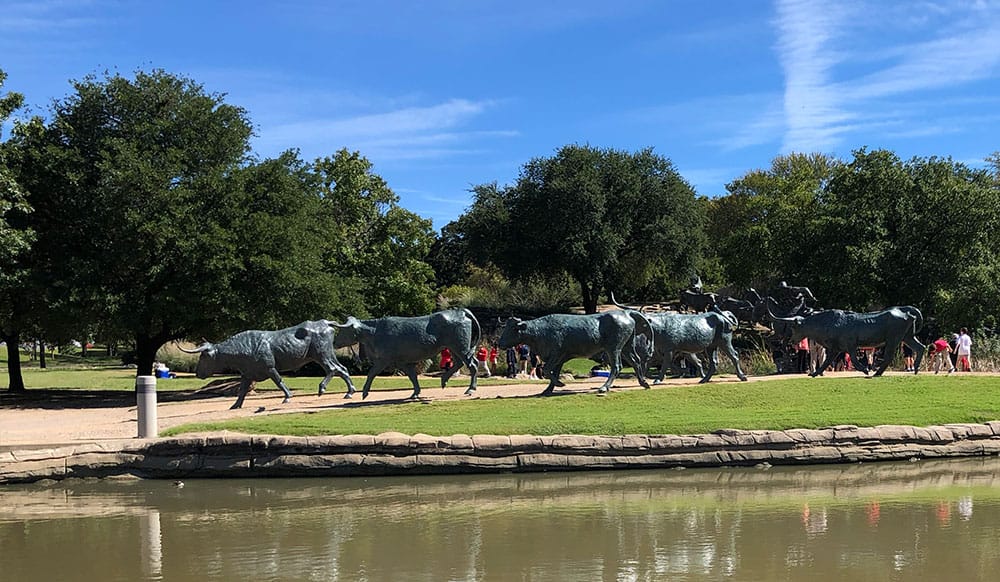
Come face-to-face with 6-feet tall steers, gathered in a herd and racing down a slope. The bronze steers are part of a larger sculpture that pays homage to the 19th-century cattle drives that passed through Dallas. The sculpture consists of 49 Texas longhorn cattle and 3 trail riders mounted atop horses.
The park recently underwent some improvements that have made it more accessible to everyone. The park’s gravel pathways are easy to roll a wheelchair across, and make it possible for wheelchair users to go straight up to the sculpture pieces.
Nearest Metro station: 0.4 miles from Convention Center Station (Blue, Green, Red lines).
Dallas Farmers Market
The Dallas Farmers Market consists of four buildings/sheds, each with a unique offering of local produce, products and crafts. I explored two of these buildings on a Sunday, referred to as “The Shed” and “The Market.”
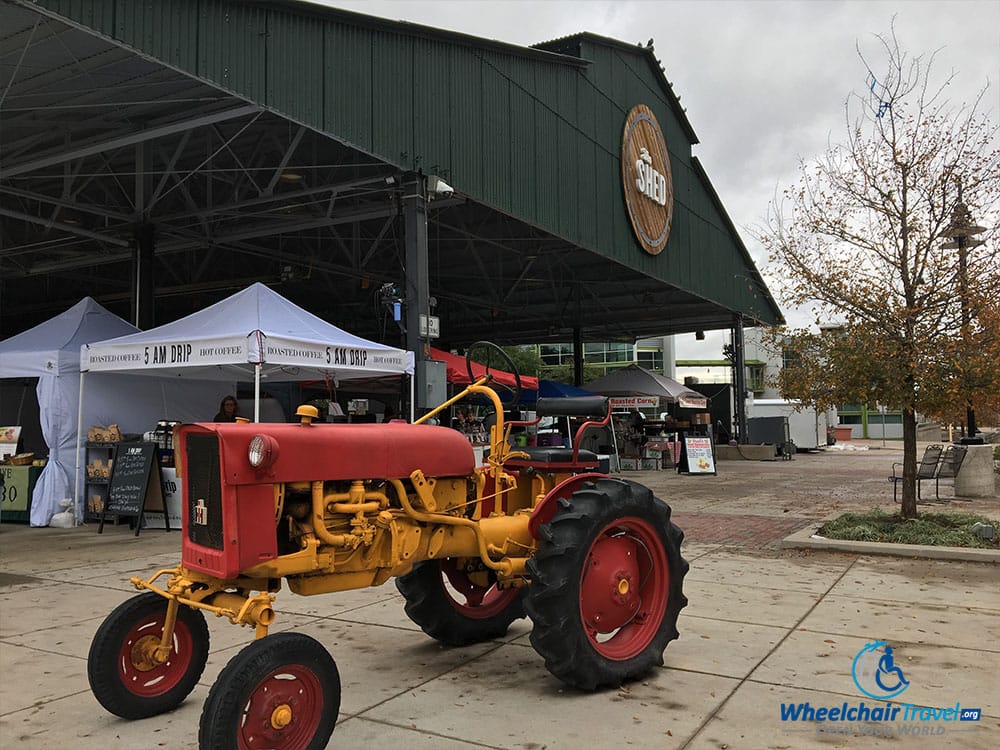

The Shed is the most traditional component of the Farmers Market – open Friday through Sunday, it is where local farmers, producers and artisans gather to sell meat, produce, baked goods and handcrafted products. The atmosphere is fantastic and many of the vendors offer free samples!
The Market is an indoor space that is home to restaurants and shops. If you are looking for a souvenir, check out the local businesses at The Market. My two favorites were Bullzerk Trailer Shop (pictured above), which creates Dallas-inspired t-shirts and apparel, and Lone Chimney Mercantile, which sells one-of-a-kind artistic home decor.
Nearest City Bus: 1 block from #035.
Pegasus at the Omni Dallas Hotel
Just outside the Omni Dallas Hotel, a flying horse – Pegasus – rotates proudly, trimmed with neon lights. The horse has a long history – it sat atop the Magnolia Building (former headquarters for the Magnolia Petroleum Company) in Downtown Dallas for more than 60 years, from 1934 to 1999.
Decaying with age, the original Pegasus was replaced. The new iteration lit up atop the new Magnolia Hotel for the first time at midnight on January 1, 2000. For more than a decade, Pegasus sat in storage and was eventually lost. In 2012, it was rediscovered in a storage shed. The incredible story of this discovery, and the restoration that followed is available in a Dallas Morning News article.
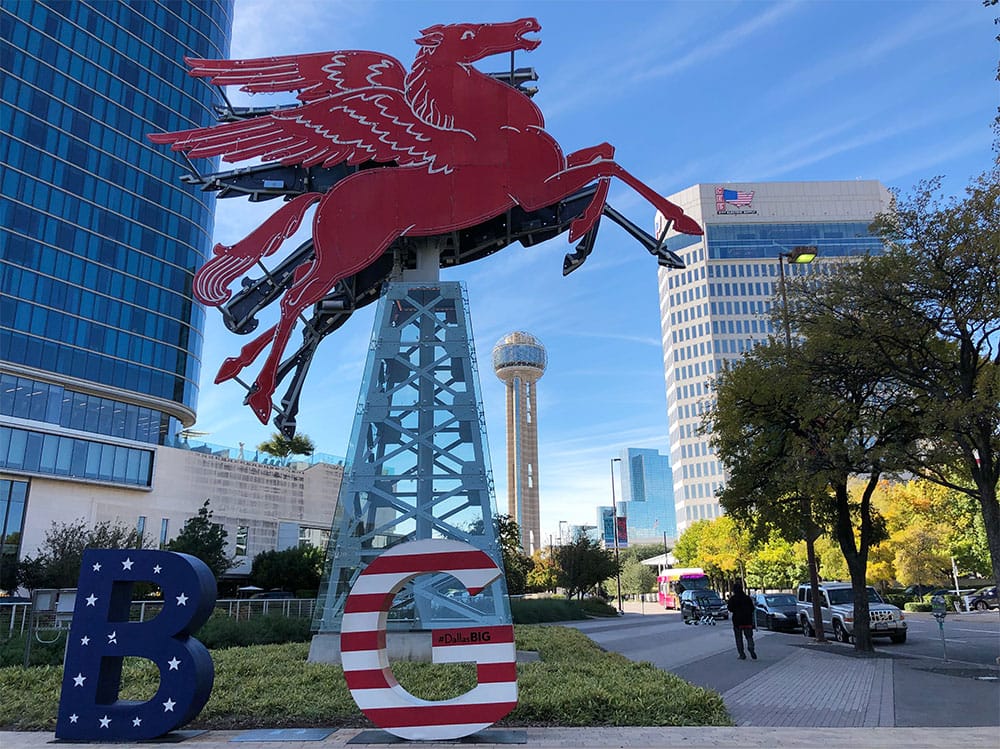
In 2015, the original Pegasus was installed outside the Dallas Omni Hotel. Anyone can visit, both at day and night. I pulled the following quote from the above-referenced newspaper article:
“For those who grew up in Dallas, Pegasus has long been our beacon, our emotional bond to the city we know as home, a link to the memories of a bygone time. Pegasus is our Gateway Arch, our Statue of Liberty.”
Indeed, if Pegasus is the Statue of Liberty of Dallas, you won’t wasn’t to miss it. History and beauty, together as one rotating neon horse!
Nearest Metro station: 0.3 miles from Union Station (Blue, Green, Red lines).
Old Red Courthouse Museum
The Old Red Museum and Dallas Visitor’s Center are located in the former Dallas County Courthouse, which was built in 1892. The building was placed on the U.S. National Register of Historic Places in 1976, and is located on Houston Street – directly across from the historic Dealey Plaza. The museum inside traces the history of Dallas, from the early settlers to the present time. Visitors will be presented with facts and figures that highlight the city’s growth over the past centuries.
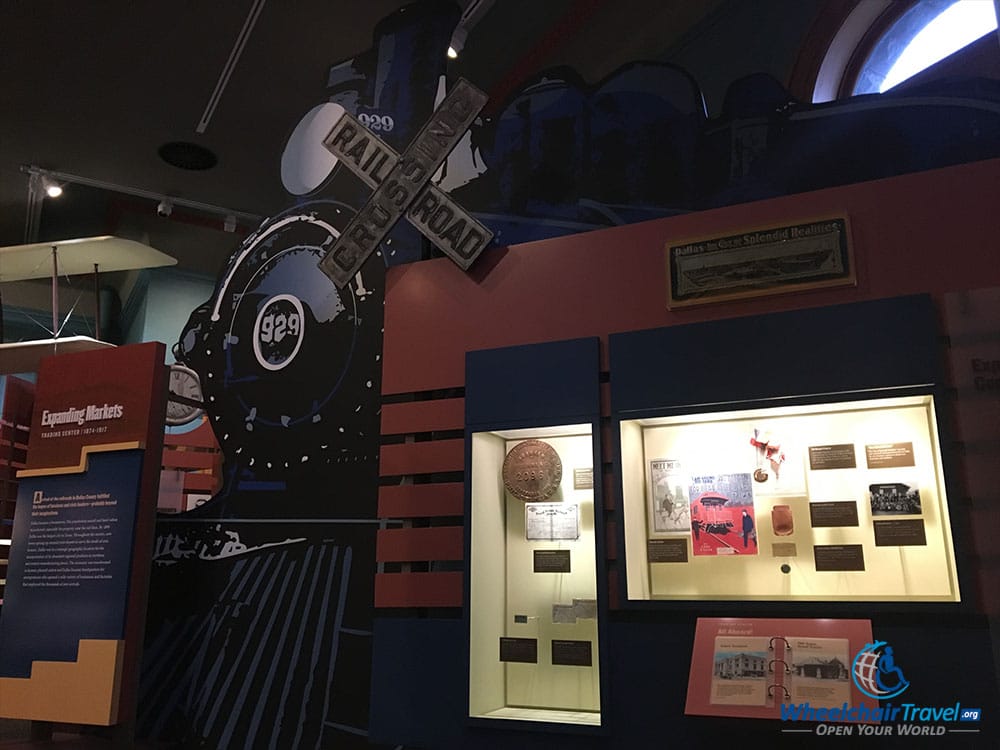
The museum, while small, is special in that it offers a unique perspective on Dallas history. The exhibits help visitors “connect the dots” to understand how the city was transformed by innovation, development, transportation and investment. I particularly enjoyed the display pictured above, which described how the railways allowed Dallas to reach new markets and transform its own economy:
“By 1890 Dallas was the largest city in Texas. Throughout the county, new towns sprung up around train depots to serve the needs of area farmers. Dallas was in a strategic geographic location for the transportation of its abundant regional products to northern and eastern manufacturing plants. The economy was transformed as farmers planted cotton and Dallas became headquarters for entrepreneurs…”
As a lover of history, sometimes museums try to wow us, but forget about the story that must be told. The Old Red Museum has found a great balance between the two. The museum is wheelchair accessible, but entry is via a ramp at the side of the building (accessed from John F. Kennedy Memorial Plaza). ADA-compliant bathroom facilities are available on the first floor. The cost of admission is $10 for adults and $8 for seniors (ages 65+) or active/retired military. For more information, visit www.oldred.org.
Nearest Metro station: 0.2 miles from West End Station (Blue, Green, Orange, Red lines).
Deep Ellum (Neighborhood)
If you enjoy live music, you’ll love Deep Ellum. The neighborhood, about one mile East of Downtown Dallas, used to be exceedingly rough. A recent revitalization has turned it into the city’s top live music scene. Visitors will find a fantastic selection of bars, restaurants and coffee shops spread across three major streets – Commerce, Main and Elm.
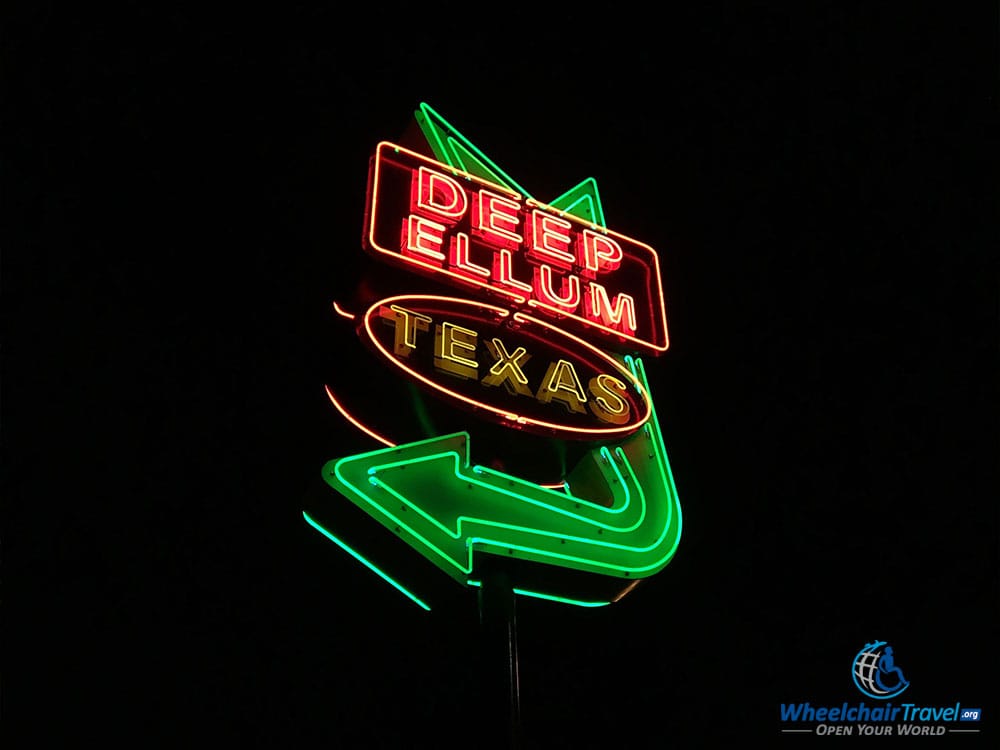
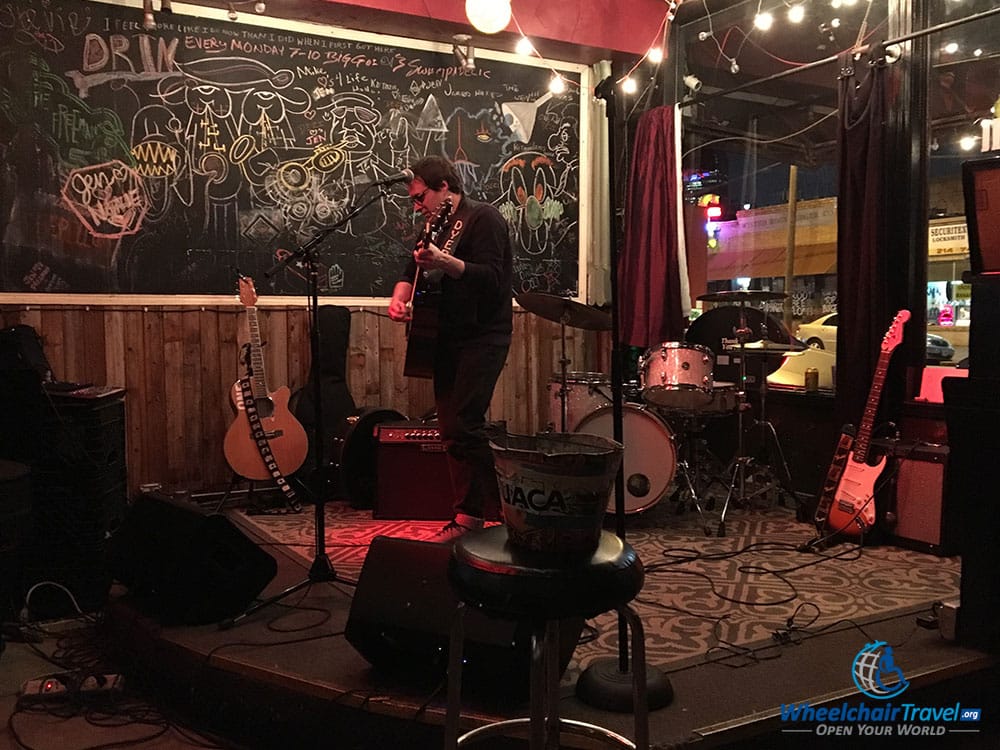
I tested out quite a few of these bars, and found a favorite spot. The Free Man Cajun Cafe & Lounge on Commerce Street is a lively bar – with at least two live music acts playing every night. I made a few friends drinking there, and found that everyone knew one another. They welcomed me into their family of music lovers and it was a real treat. The Free Man has wheelchair accessible bathrooms – one for men, another for women – but both are private. Right next door to The Free Man is Adair’s Saloon, also a must-visit for first timers in Deep Ellum.
You may also enjoy having a drink at the quiet Twilite Lounge, or take in the performances at Louie Louie’s Piano Bar – both on Elm Street. The best snack can be found at Emporium Pies, on Main Street in Deep Ellum.
Some of the sidewalks in Deep Ellum are a bit dodgy, with broken and cracked cement/brick, but curb cuts are intact. The live music scene and experience are worth the few bumps and obstacles!
Nearest Metro station: 0.2 miles from Deep Ellum Station (Blue, Green, Orange, Red lines).
Dallas Zoo
Another zoo? That’s exactly what I was thinking when I added the Dallas Zoo to my schedule. From an accessibility standpoint, they’re all fairly similar – you roll up to a window or a fence and look at different species of wildlife. But the Dallas Zoo, located in South Dallas along Interstate 35, had some surprises in store. It was as if the zoo spirits shouted, “Zoological parks are NOT all the same!” Before I explain, take a look at these photographs from my visit:
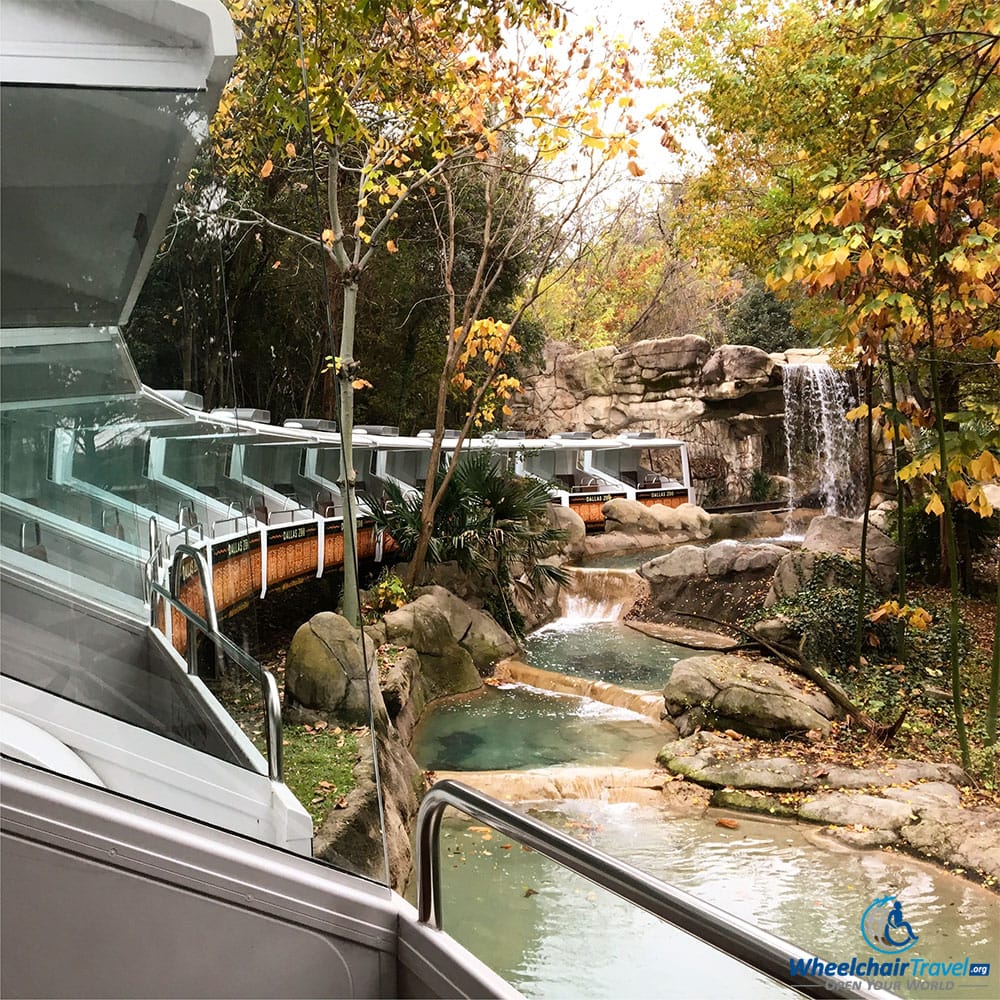

I took the first photo while aboard the Wilds of Africa Adventure Safari Monorail. To my surprise, it was wheelchair accessible! I rolled straight in, parked and was able to embark on a 30-minute ride (with a tour guide/driver) through the zoo. The monorail’s design offered me an unobstructed view of the wildlife – from elephants to chimpanzees and birds of all types. The ride costs an extra $5, but is definitely worth it.
The second photo is a close-up shot of a cheetah – an absolutely beautiful creature. The cheetahs happened to be lounging right up against the glass window, which allowed me to take such a great picture. This particular cheetah had quite the personality, but was generally disinterested with me.
The cost of admission to the zoo is $15 for adults and $8 for seniors (ages 65+) from March through November. Everyone gets in for a reduced price of $7 during the months of December through February. For more information, visit www.dallaszoo.com.
Nearest Metro station: 1 block from Dallas Zoo Station (Red line).
Dallas Arts District (Neighborhood)
The Dallas Arts District, a segment of Downtown Dallas, is the largest contiguous urban arts district in the United States. The district is home to three art museums (two of which are reviewed later in this article), numerous performing arts venues and a significant collection of public parks, churches and other community centers.
You’ll also find restaurants, coffee shops and hotels located within the district, making this area a treasured part of the city’s downtown. For more information and to see what’s happening in the Arts District, visit www.dallasartsdistrict.org.
Dallas Museum of Art
The Dallas Museum of Art traces its history to 1909, when the City of Dallas received its first art donation. The collection was placed in a new building at the state fairgrounds, which became the Free Public Art Gallery of Dallas.
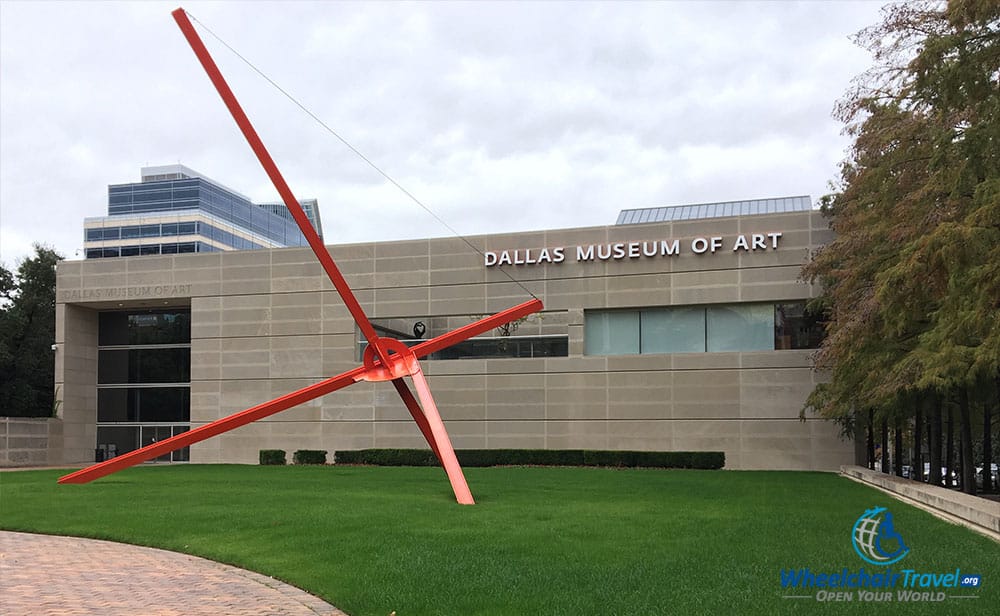
Since 1984, the DMA has occupied the building at its present location downtown – at the center of the Dallas Arts District. More than 24,000 pieces of comprise the museum’s collection of art, some dating back more than 5,000 years. The collection is diverse, with works from Africa, Asia, Europe, the Mediterranean and North America.
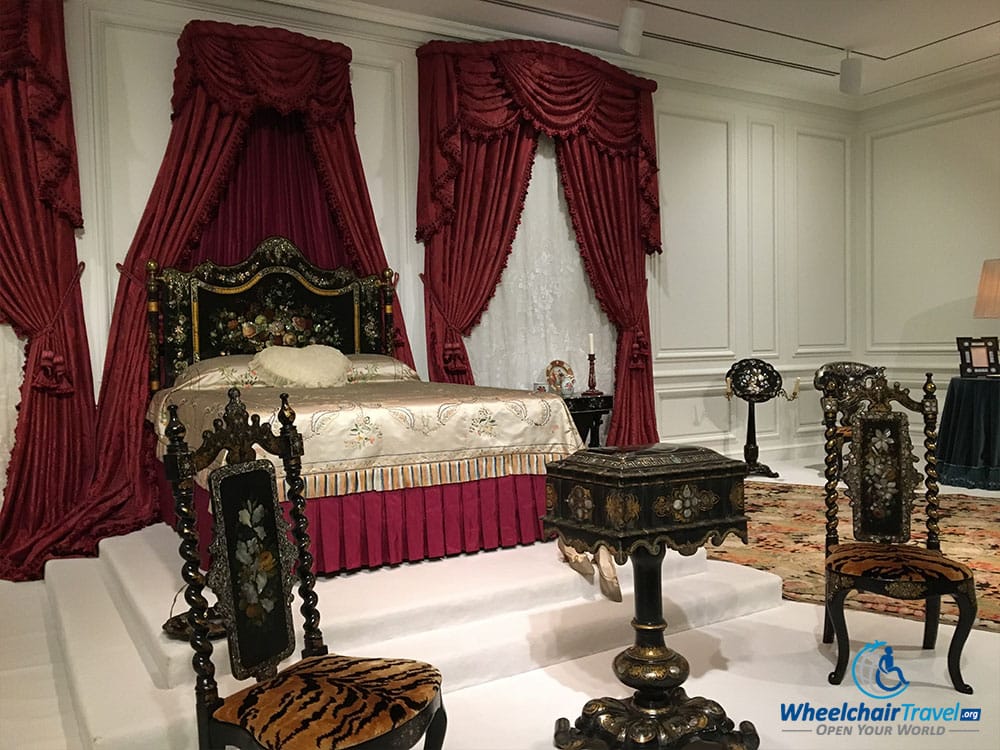
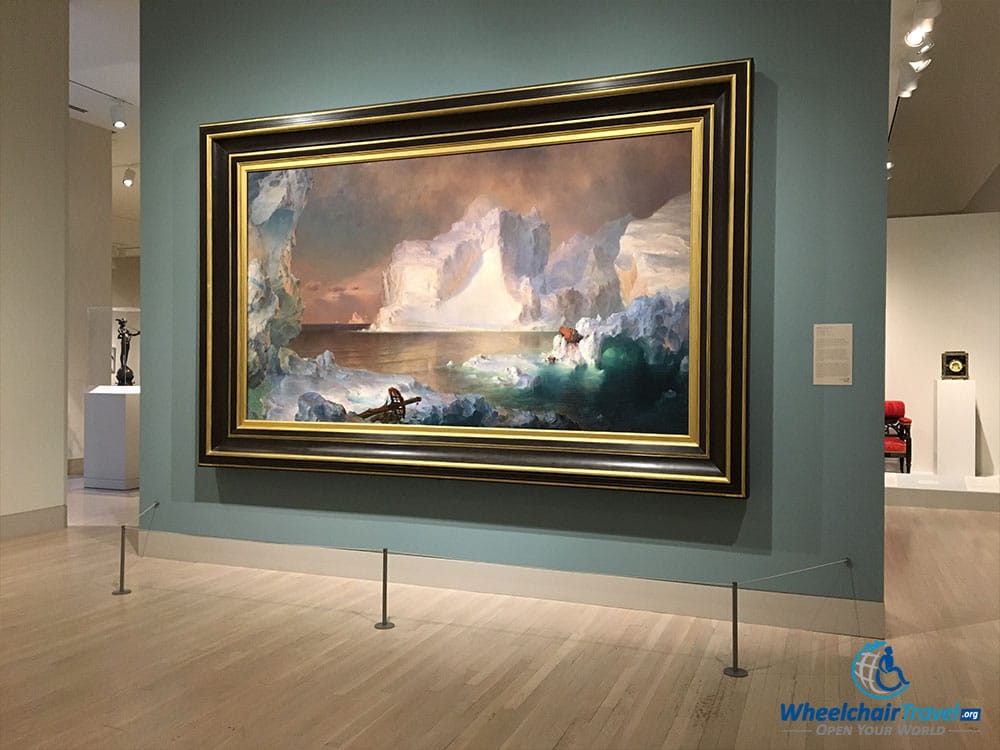
The Wendy and Emery Reeves Collection is the most popular of the museum’s exhibitions. Donated to the museum in 1985, the collection is housed in a 15,000-square-foot reproduction of the couple’s home in France. The original home was built by French fashion designer Coco Chanel. The exhibition has been designed to invite visitors into the Reeves’ home, where they will see an impressive collection of artwork – including pieces by Edgar Degas, Paul Gauguin, Edouard Manet, Claude Monet, Renoir and Vincent van Gogh.
Outside of the Reeves’ Collection is a piece by Frederic Church, an 1861 oil painting, The Icebergs. The work is captivating, due to the fascinating depiction of light interacting with the natural features of an arctic landscape. Church’s painting is owned by the DMA, but is occasionally exhibited in other art museums – most recently at the Metropolitan Museum of Art in New York City.
Wheelchair accessibility at the DMA is excellent, with lifts and/or ramps to each of the floors and galleries. Accessible bathroom facilities are available throughout the museum. Admission is free to everyone, but there is a charge to access certain temporary of visiting collections. For more information, visit www.dma.org.
Nearest Metro station: 0.4 miles from St. Paul Station (Blue, Green, Orange, Red lines).
Nasher Sculpture Center
Home to the Raymond and Patsy Nasher Collection, the Nasher Sculpture Center has been recognized as having one of the finest modern and contemporary sculpture collections in the world.
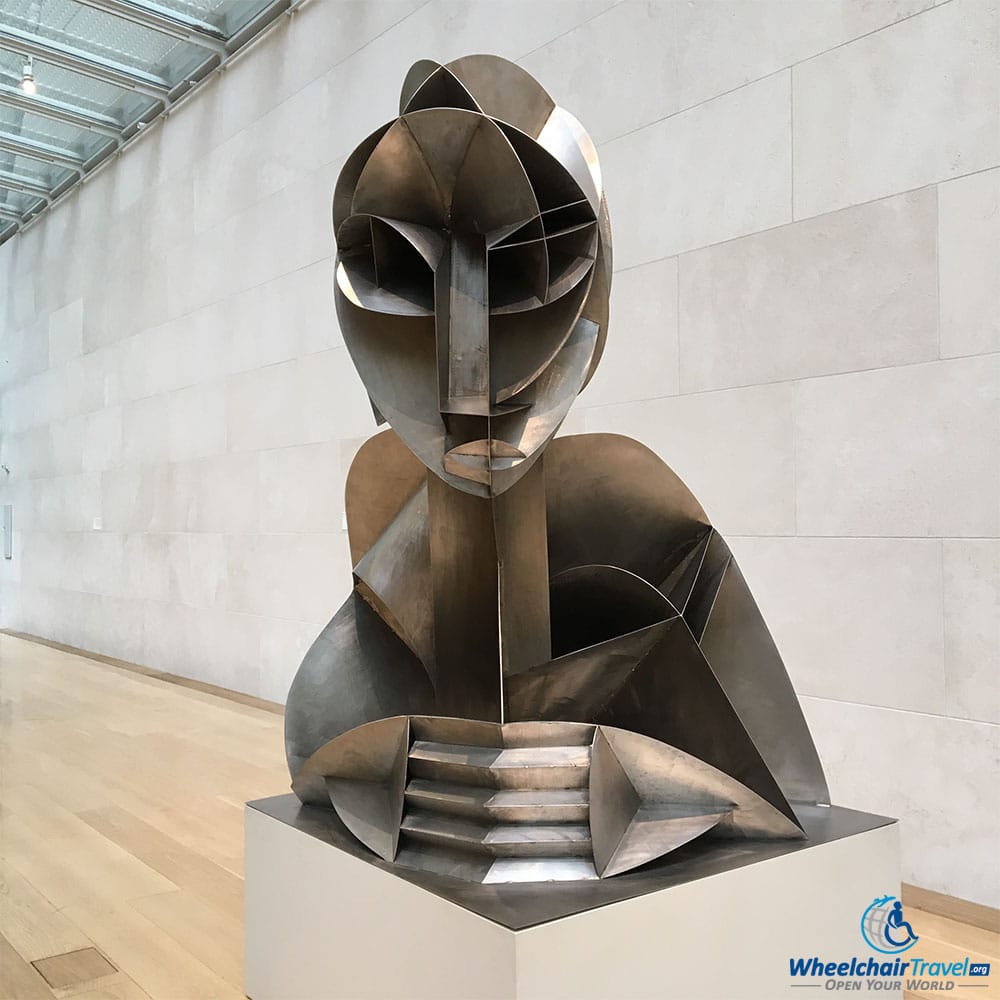
Because the pieces frequently rotate in and out of the exhibit halls, no two visits to the Nasher Sculpture Center are the same. In addition, the center shows numerous temporary exhibits throughout the year – adding a touch of artistic flavor from outside the center’s own collection.
Pictured at left is Constructed Head No. 2, a stainless steel piece by Naum Gabo, who forged the work in 1916 in Russia. I loved the unique design, and thought the center’s description was spot on: “These works open up inner form to light, space, shadows, and reflections, minimizing solidity of mass and surface.”
The collection also contains pieces by other notable artists, including Calder, Hepworth, Kelly, Matisse, Picasso, Rodin and Serra. Each of the museum’s galleries are wheelchair accessible, via elevator. You’ll also find wheelchair accessible pathways throughout the outdoor sculpture garden.
The price of admission is $10 for adults and $7 for seniors (ages 65+) or active/retired military. For ore information, visit www.nashersculpturecenter.org.
Nearest Metro station: 0.4 miles from St. Paul Station (Blue, Green, Orange, Red lines).
Perot Museum of Nature and Science
In my opinion, the Perot Museum of Nature and Science, also located in the Dallas Arts District, is a must-visit attraction. The museum is uniquely Dallas, telling the story of scientific developments that affect the local area – particularly with respect to energy, oil and gas. The permanent exhibitions include Sports, Discovering Life, Being Human, Engineering and Innovation, Dynamic Earth, Gems and Minerals, Energy and Expanding Universe.
If you have read my article on Things to Do in Indianapolis, you may have watched a video of me “racing” a Cheetah in my wheelchair. I was able to recreate that experience at the Perot Museum’s interactive exhibit, Sports Run:
As you can see, the cheetah beat me. Good thing I don’t anticipate ever having to flee from one, as I would certainly be gobbled up in about a second.
I was able to participate in another fun experience in the Rees-Jones Foundation Dynamic Earth exhibit. A shake table simulates the effect of an earthquake. I chose the “extreme” setting, and nearly flew out of my wheelchair:
The Perot Museum includes many other interactive exhibits that are also wheelchair accessible – too many to count, in fact. The museum facility was built in 2012, and is fully ADA-compliant. General admission costs $19 for adults and $13 for seniors (ages 65+). For more information, visit www.perotmuseum.org.
Nearest Metro station: 0.6 miles from Akard Station (Blue, Green, Orange, Red lines).
Winspear Opera House
The AT&T Performing Arts Center’s Margot and Bill Winspear Opera House opened its doors in 2009 and is home to The Dallas Opera and the Texas Ballet Theater. The Winspear has hosted a wide array of performance artists throughout its history. I had the pleasure of attending an Itzhak Perlman concert there in 2018.
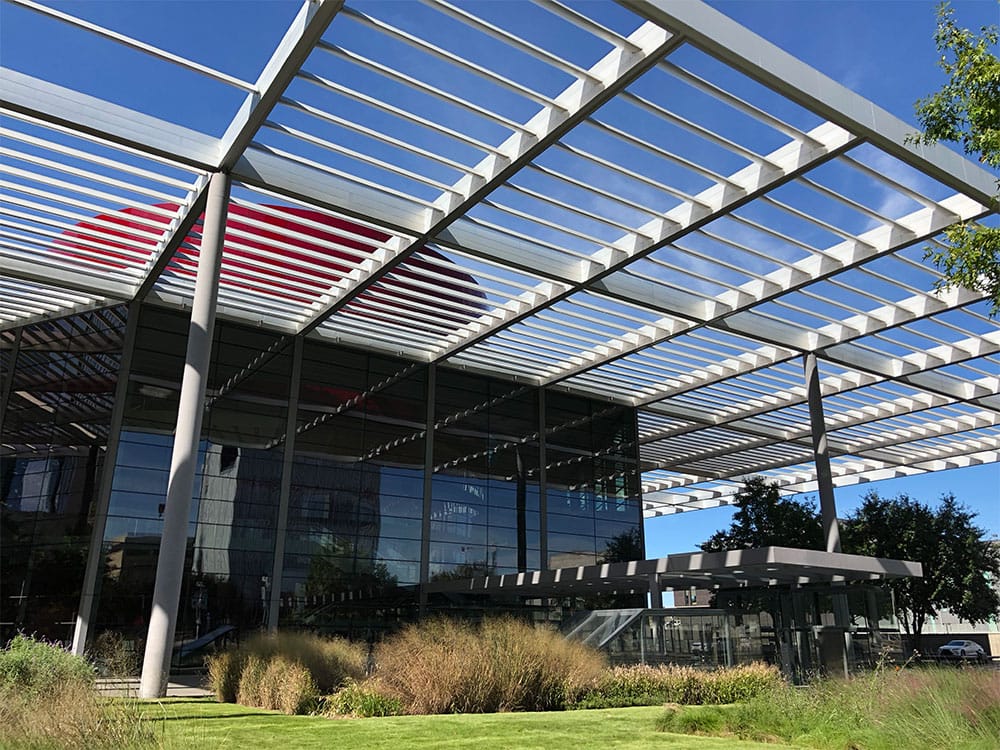
Wheelchair accessibility at The Winspear Opera House is good, as the building was designed and constructed with ADA compliance in mind. Accessible seats and wheelchair spaces are available in all price levels. Staff are helpful and accommodating at every turn, ensuring the concert experience is both accessible and enjoyable.
For more information and for a list of upcoming performances, visit www.attpac.org.
Nearest Metro station: 0.3 miles from Pearl/Arts District Station (Blue, Green, Orange, Red lines).
Klyde Warren Park
5.2 acres of green space spanning 3 city blocks sits atop a section of the underground Woodall Rogers Freeway in Downtown Dallas, forming the Klyde Warren Park. The park is a popular gathering place for locals and features well-manicured lawns and gardens, as well as wheelchair accessible pathways.
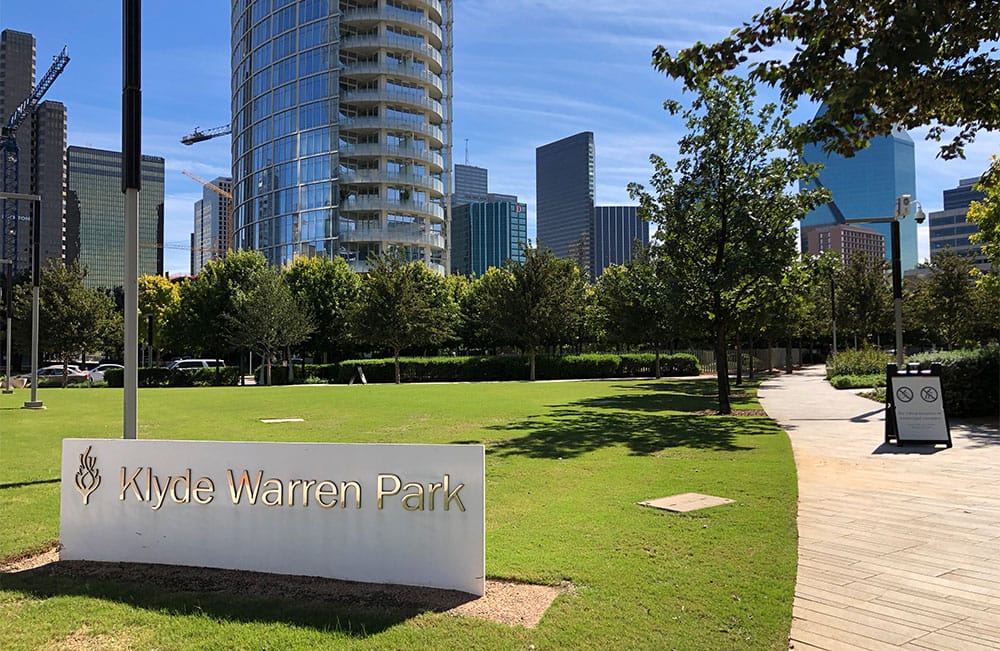
Located between Pearl Street and St. Paul Street, the park is within walking distance of the Opera House, Dallas Art Museum, Nasher Sculpture Center and other Arts District mainstays.
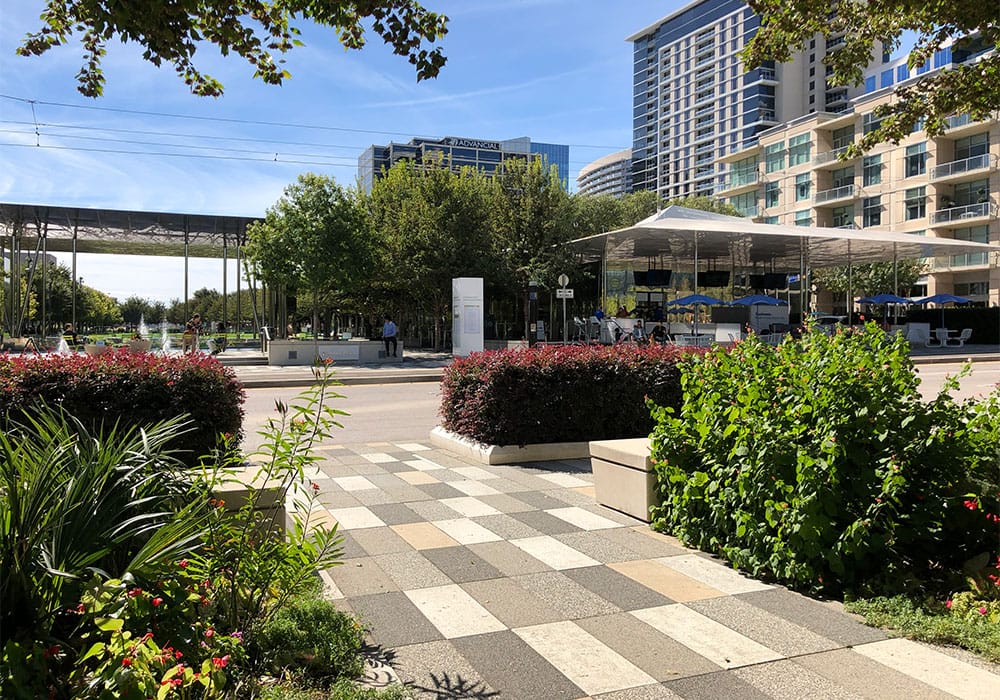
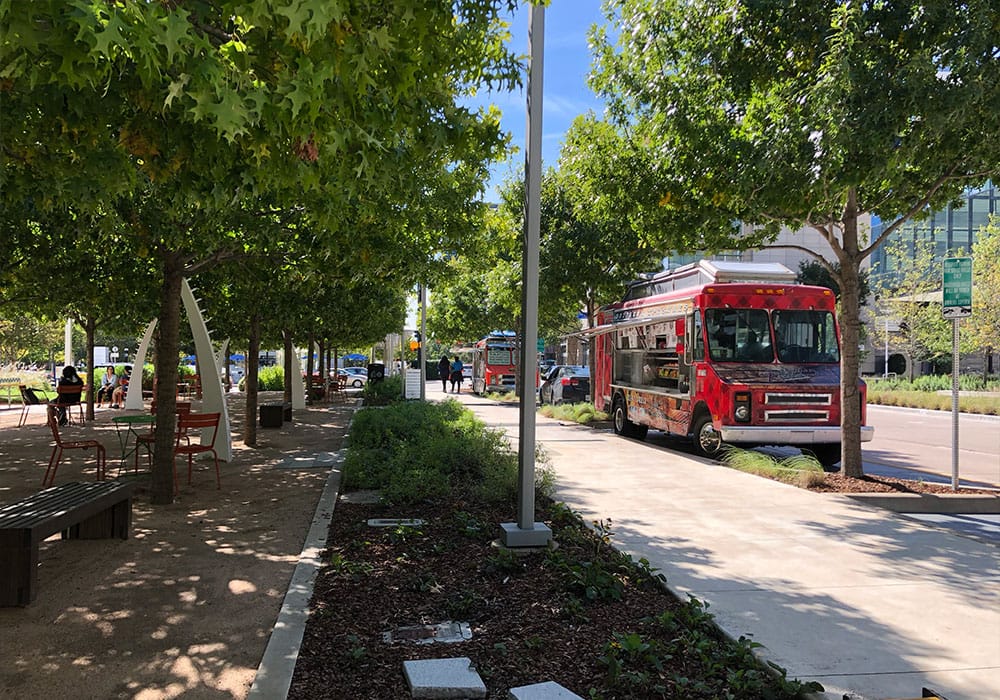
Colorful foliage and plenty of shady spots can be found throughout the park, making this a great place to take a break while exploring the city. Food trucks line up on the streets surrounding the park and many people stop here for lunch. For more information, visit www.klydewarrenpark.org.
Bishop Arts District (Neighborhood)
The Bishop Arts District may be the most unique neighborhood in the City of Dallas. Some 60 restaurants, shops and boutiques operate within the area, all owned independently. I had the chance to explore Bishop Arts with a friend, and we hit up The Wild Detectives – a bookstore that serves beer and wine, in addition to the more-traditional coffee and tea. On the night I visited, the bookstore was hosting a reading from a local author – a really neat experience. The outdoor patio is a great place to sit, if the weather is nice. The Wild Detectives is wheelchair accessible via a ramp at the right-rear of the building. You’ll find that most of the other shops and businesses are also accessible, but call in advance to be certain. For a complete list of places to go, visit www.bishopartsdistrict.com.
The district is easy to access from downtown, via the free-to-ride street car which runs between Bishop Arts and Union Station. A great deal of construction is underway to improve the “roll-ability” of the streets and sidewalks in the neighborhood. My power wheelchair easily handled the small barriers that do remain.
Texas Theatre
Opened in 1931 and financed by Howard Hughes, the Texas Theatre gained national attention in 1963 as the place where Lee Harvey Oswald was arrested by police. The theatre remains open as a movie cinema today, but shows only classic films.
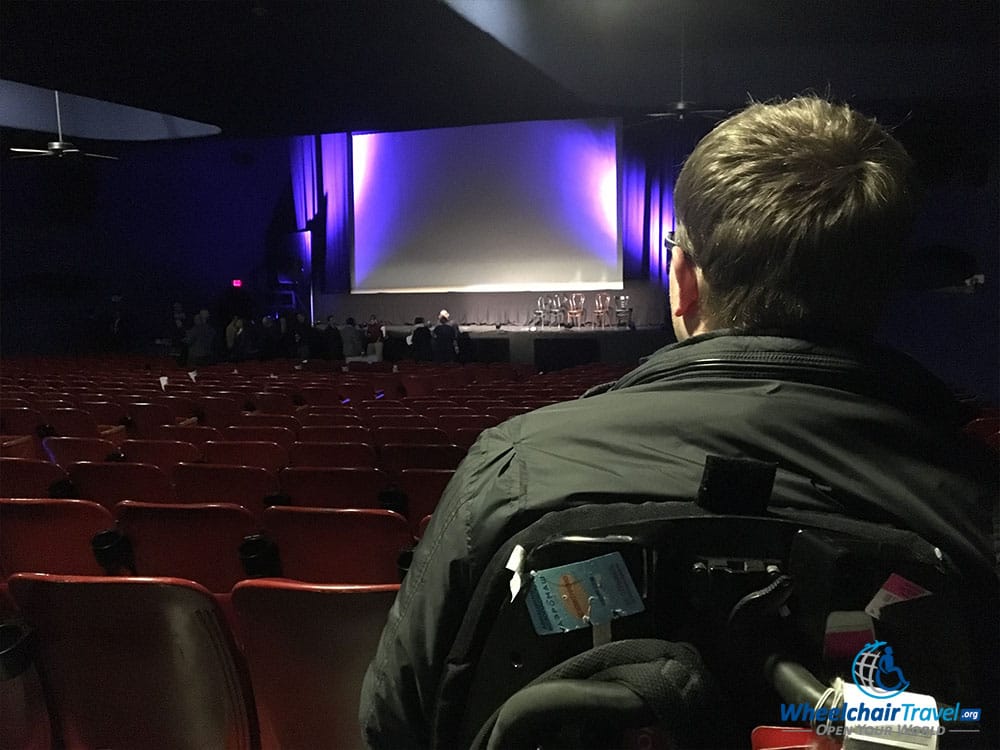
During my exploration of the Bishop Arts District, I walked by and saw that a private event – an award ceremony for entrepreneurs – was letting out. My friends and I walked into the theatre, and purchased drinks from the cash bar. This allowed us the opportunity to tour the movie theatre, and I was happy to find that it is wheelchair accessible.
Reserved seating spaces for wheelchairs are available at the rear of the auditorium, and also at the center. Wheelchair accessible bathrooms are located in the lobby, which also has a few classic video games, including Ms. Pac-Man. For more information on the theatre and a listing of showtimes and events, visit www.thetexastheatre.com.
Nearest STREETCAR station: 0.5 miles from Bishop Arts Station (Dallas Streetcar).
George W. Bush Presidential Library and Museum
If you haven’t visited a presidential library before, don’t miss this one! The George W. Bush Presidential Library and Museum was opened in 2013, on the campus of Southern Methodist University. Presidential libraries serve multiple purposes – they offer former presidents a place to share their story and recognize those who worked alongside them. They are also centers of historical preservation and research, and exist long after a president has passed away.
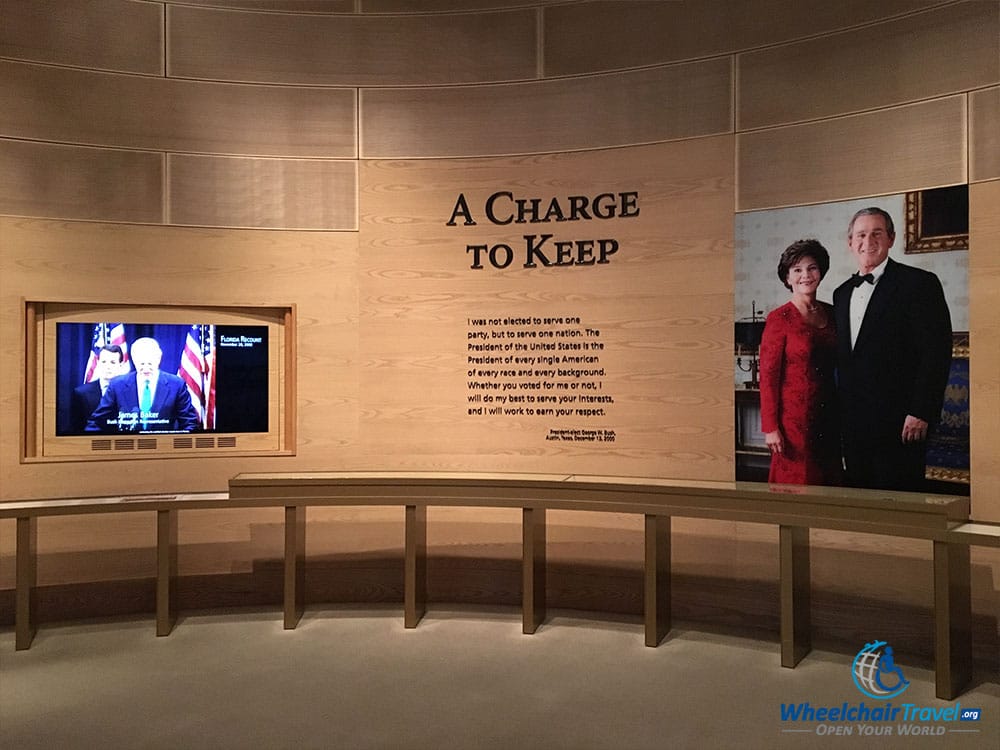
The space pictured above greets visitors at the start of the presidential museum tour. Printed on the wall is a quote from then-President-elect George W. Bush, after he had been declared winner of the 2000 election:
“I was not elected to serve one party, but to serve one nation. The President of the United States is the President of every single American of every race and every background. Whether you voted for me or not, I will do my best to serve your interests, and I will work to earn your respect.”
Whether the former president accomplished that is for you to decide. But I felt as though that quote set the tone for the museum tour, as the exhibits highlighted Bush’s time in office. Particularly interested to me were those that memorialized the September 11th attacks, and traced the wars that followed. The displays were colorful and accessible, with frequent multimedia and video elements.

The highlight of every presidential museum tour is the opportunity to take a photograph in the Oval Office. The one located here was built to the exact specifications of the real Oval Office, allowing visitors to see where the former president worked.
Accessibility at the museum and inside its galleries is excellent – the building was only recently constructed and is fully ADA-compliant. The price of admission is $16 for adults, $13 for seniors (ages 62+), $10 for retired military and free for active military. For more information, visit www.bushcenter.org.
Public Transport: Bus numbers 743 and 768 stop provide transportation between the Bush Library and Mockingbird metro station (Blue, Orange, Red lines).



